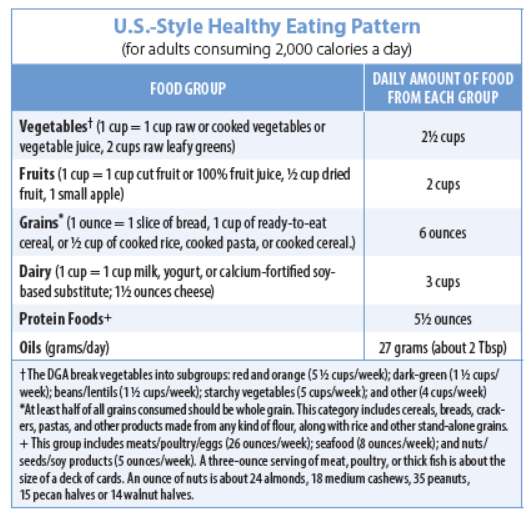The Dietary Guidelines for Americans (DGA) aim to bring together the latest scientific information on what to eat and drink to promote health, help reduce risk of chronic disease, and meet nutrient needs. To harness the science-backed health-promoting power of the DGA, make changes that move you toward their four key guidelines:
- Follow a healthy dietary pattern throughout your life. The new Guidelines stress that it’s never too early or too late to eat healthy! According to the DGAs, core elements that make up a healthy dietary pattern include:
- Vegetables—including dark green, red, and orange vegetables, and beans/lentils (as well as starchy and other vegetables)Follow a healthy dietary pattern throughout your life. The new Guidelines stress that it’s never too early or too late to eat healthy! According to the DGAs, core elements that make up a healthy dietary pattern include:
- Fruits, especially whole fruit—fresh, frozen, or dried
- Grains, at least half of which are whole grain
- Dairy, including fat-free and low-fat milk, yogurt, and cheese, and/or lactose-free versions or fortified soy beverages and yogurts
- Protein-containing foods including seafood, poultry, eggs, lean meats, beans/lentils, nuts, seeds, and soy products
- Oils, including plant oils and oils in foods like seafood and unsalted nuts
For a basic outline of a healthy dietary pattern for an adult consuming 2,000 calories a day, see the “U.S.-Style Healthy Eating Pattern” box below.
2. Make Every Bite Count. The theme of the new Guidelines is “Make Every Bite Count.” They recommend choosing nutrient-dense foods and beverages while staying within calorie limits. Nutrient-dense foods provide our bodies with more of the nutrients we need for optimal health per calorie than versions of those foods high in solid fats and added sugars. For example: a burger patty made from three ounces of 97 percent lean ground beef has 100 less calories than the same size burger made from 80 percent lean meat, along with more protein, iron, and other nutrients. Cereals without added sugars are more nutrient dense than sugary choices, roasted veggies have more nutrients per calorie than fried versions, carrot and celery sticks are a better choice than salted veggie chips.
“When faced with modern hyper-processed packaged foods or supersized restaurant meals, staying within calorie limits can be a real challenge,” says Dariush Mozaffarian, MD, DrPH, dean of the Friedman School and editor-in-chief of Tufts Health & Nutrition Letter. “Fortunately, research shows that eating more minimally processed, nutrient-dense foods can help our bodies naturally stay closer to our calorie limits. In contrast, eating more processed, starch- and sugar-rich foods can push us over the edge and toward steady, gradual weight gain.”Make Every Bite Count. The theme of the new Guidelines is “Make Every Bite Count.” They recommend choosing nutrient-dense foods and beverages while staying within calorie limits. Nutrient-dense foods provide our bodies with more of the nutrients we need for optimal health per calorie than versions of those foods high in solid fats and added sugars. For example: a burger patty made from three ounces of 97 percent lean ground beef has 100 less calories than the same size burger made from 80 percent lean meat, along with more protein, iron, and other nutrients. Cereals without added sugars are more nutrient dense than sugary choices, roasted veggies have more nutrients per calorie than fried versions, carrot and celery sticks are a better choice than salted veggie chips.
3. Personalize It. The 2020-2025 edition of the DGA puts added emphasis on choosing a meal pattern to suit your personal needs. Within each food group, pick the health-promoting foods that most appeal to you—including your personal preferences, cultural traditions, and budgetary considerations. A lot is written about the health benefits of eating certain foods, like salmon or blueberries—but, if you don’t like these foods, other seafood and fruit choices are good as well. Kale gets all the attention—but if you grew up with collards, turnip greens, or taro leaves, don’t stop eating them (just avoid some of the traditional preparation methods with high levels of sodium and unhealthy fats).
4. Limit Undesirable Nutrients. Dietary patterns that contain foods higher in added sugars, unhealthy fats, and sodium have consistently been associated with higher risk for chronic diseases.
- Added sugars: The DGA recommend infants and toddlers avoid all added sugars, and people ages two and older limit added sugars to less than 10 percent of calories. The committee advising the DGA update proposed reducing this limit even further—to 6 percent of calories. “Don’t worry about calculating a percentage,” says Alice H. Lichtenstein, DSc, a professor at the Friedman School and executive editor of Tufts Health & Nutrition Letter. “It’s more important to identify those foods and beverages that contribute the most added sugars to your diet and determine how to reduce intake, either by switching to lower sugar products, consuming smaller portions, and/or eating them less frequently,”
- Saturated Fats: The DGAs recommend saturated fat be limited to less than 10 percent of calories starting at age two. “We recommend focusing on food sources, rather than counting saturated fat,” says Mozaffarian. Minimize processed meats and eat no more than one or two servings of unprocessed red meats a week; use healthful plant oils (like soybean, canola, olive, avocado, and corn oils) and spreads rich in these oils instead of butter or lard; and avoid palm and palm-kernel oils. “The DGAs suggest low-fat dairy products to help control calorie intake,” says Mozaffarian. “Emerging scientific evidence suggests type of dairy is more important than the fat content, with the greatest evidence for health benefits of yogurt, then cheese, then milk.”
- Sodium: To decrease risk of strokes and heart disease related to high blood pressure, the DGAs recommend keeping sodium intake below 2,300 milligrams (mg) per day (and even lower for those younger than age 14). Identifying and cutting back on high-sodium foods (both in packaged foods and at restaurants) is most important. All packaged foods list milligrams of sodium per serving on the Nutrition Facts label. Compare this number to 2,300 to see how much of a dent that food would make in the daily recommended allotment. You can compare labels of similar foods to find the lowest-sodium version.
- Alcoholic beverages: If you drink alcohol, the DGA continue to recommend no more than two drinks a day for men and one drink or less a day for women. Drinking less is better for health than drinking more. (The 2020 DGA scientific advisory committee recommended the limit for men be further reduced to no more than one drink per day.) Women who are pregnant or trying to become pregnant should not drink alcohol. A “drink” is 12 ounces of beer (five percent alcohol by volume), five ounces wine, or one-and-a-half ounces liquor.
The recommendations concerning alcohol and added sugar are receiving a lot of attention, not because they are new, but precisely because they are not new. “The committee of experts who reviewed all the latest scientific information recommended further lowering the acceptable alcohol intake for men and the upper limit on added sugar intake for everyone,” says Mozaffarian. “The USDA did not accept this recommendation, and I worry that politics trumped science in this part of the guidelines.”
This controversy does not need to impact our day-to-day decisions about added sugars and alcohol, however. “Simply remember,” suggests Lichtenstein, “when it comes to added sugars, less is better. When it comes to alcohol responsibility and moderation are critical considerations, from the perspective of health, safety, interpersonal relationships, and calorie balance.”
Looking at all the research, there is ample evidence that making small changes to bring our diet more in line with the Dietary Guidelines for Americans can help us take charge of our personal health and well-being—one bite at a time.

To nourish your body and reduce your risk for diet-related chronic disease, try these tips:
- Meet nutritional needs primarily from foods and beverages, as opposed to vitamin pills and other dietary supplements.
- Choose a variety of options from each food group. A variety of foods ensures a variety of nutrients.
- Pay attention to portion size. If you make healthy choices and don’t overeat, you’re more likely to stay within your calorie needs.
- Cut down on added sugars and sodium by identifying the largest contributors in your diet and cutting back, finding healthier versions, and/or eliminating them.
- Replace saturated fats with unsaturated fats, primarily by choosing plant oils over animal fats, avoiding tropical plant oils (especially palm and palm kernel), and choosing leaner cuts of meat.
























